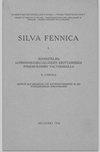Leaching of heavy metals and barium from forest roads reinforced with fly ash
IF 1.7
3区 农林科学
Q2 FORESTRY
引用次数: 5
Abstract
The aim of this study was to determine the effect of leaching of heavy metals (Cr, As, Cd, Cu, Ni, Pb, Zn, Co, Mo) and earth-alkaline metal, barium (Ba), on the percolation and ditch water quality from the forest roads that contained ash in the road structures. Water quality was studied in the immediate vicinity below the ash layers as well as deeper in the road structure. Water quality was also determined in the drainage water in ditches that crossed the forest roads. A mixture of wood and peat based fly ash was used in the road structures. The treatments were: 1) no ash, 2) a 15 cm layer of ash/gravel mixture, 3) a 20 cm layer of ash/gravel mixture, 4) a 25 cm layer of ash, and 5) a 50 cm layer of ash. Large variation in the concentrations of Cr, As, Cu, Ni, Pb, Mo and Ba in the percolation water, even within the same treatment, caused difficulties to generalize the results. The concentrations of Cr, As, Ni, Pb, Mo and Ba in water samples were high in some treatment plot lysimeters containing ash compared to the control (no ash). On the other hand, many lysimeters had low and similar concentrations in water samples in the treatment plots containing ash compared to concentrations in the control plots. The ash in the roads did not affect the concentrations in the ditches. The leaching is uneven and seems to take place only from some parts of the ash layer. Risk for leaching is minimal if such parts are not widely spread.粉煤灰加固林道中重金属和钡的浸出
本研究的目的是确定重金属(Cr、As、Cd、Cu、Ni、Pb、Zn、Co、Mo)和碱土金属钡(Ba)的浸出对道路结构中含有灰烬的森林道路的渗滤和沟渠水质的影响。对灰层下方紧邻区域以及道路结构深处的水质进行了研究。还测定了穿过森林道路的沟渠中的排水水质。道路结构中使用了木材和泥炭基飞灰的混合物。处理为:1)无灰,2)15cm的灰/砾石混合物层,3)20cm的灰/砂砾混合物层,4)25cm的灰层,和5)50cm的灰层。渗滤液中Cr、As、Cu、Ni、Pb、Mo和Ba的浓度变化很大,即使在相同的处理范围内,也难以推广结果。与对照(无灰)相比,在一些含有灰的处理小区渗滤液中,水样中Cr、As、Ni、Pb、Mo和Ba的浓度较高。另一方面,与对照区的浓度相比,许多蒸渗仪在含有灰烬的处理区的水样中的浓度较低且相似。道路上的灰烬并没有影响沟渠中的浓度。浸出是不均匀的,似乎只发生在灰层的某些部分。如果这些部分没有广泛分布,浸出的风险是最小的。
本文章由计算机程序翻译,如有差异,请以英文原文为准。
求助全文
约1分钟内获得全文
求助全文
来源期刊

Silva Fennica
农林科学-林学
CiteScore
3.50
自引率
11.10%
发文量
21
审稿时长
3 months
期刊介绍:
Silva Fennica publishes significant new knowledge on forest sciences. The scope covers research on forestry and forest ecosystems. Silva Fennica aims to increase understanding on forest ecosystems, and sustainable use and conservation of forest resources. Use of forest resources includes all aspects of forestry containing biomass-based and non-timber products, economic and social factors etc.
 求助内容:
求助内容: 应助结果提醒方式:
应助结果提醒方式:


